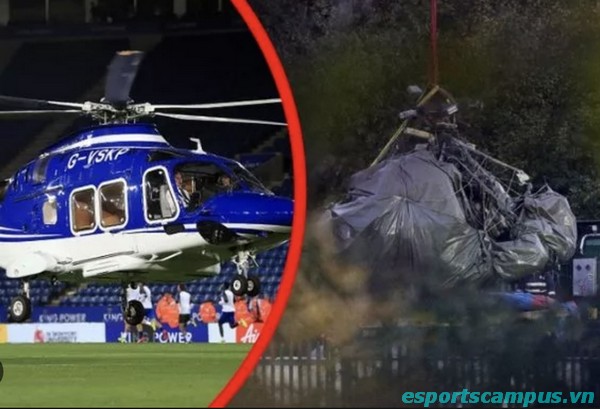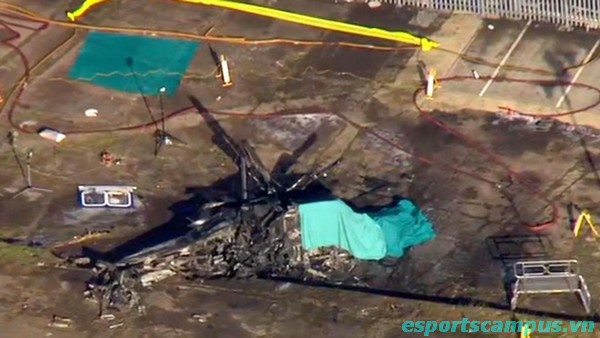Leicester Helicopter Crash was a Tragic Accident for the club
The Leicester helicopter crash of 2018 stands as a haunting and somber reminder of the fragility of life and the unpredictability of tragedy! It was an evening etched in the memories of football enthusiasts and aviation experts alike, a night when the joy of a thrilling football match was eclipsed by the horrifying descent of a helicopter from the skies above the King Power Stadium. The words of the pilot, “I don’t know what’s happening,” still echo in the hearts of those who witnessed the harrowing incident. In this narrative, we embark on a journey to unravel the layers of this tragic event, examining its causes, consequences, and the profound lessons it imparts about the imperative of aviation safety. Read more at esportscampus.vn!

I. Introduction about the Leicester helicopter crash
The year 2018 marked a tragic chapter in the history of Leicester City Football Club when a fateful helicopter crash unfolded at the club’s home ground, the King Power Stadium. This incident left an indelible mark on the collective memory of football fans worldwide. The aftermath of the crash, which claimed the lives of five individuals, brought with it a profound sense of grief and disbelief.
On the evening of October 27, 2018, after a thrilling match, the helicopter carrying Leicester City’s beloved owner, Vichai Srivaddhanaprabha, and four others met with a devastating accident. The incident occurred just moments after the aircraft had taken off, leaving witnesses in shock as the helicopter lost control and plunged to the ground in a fiery catastrophe.
Vichai Srivaddhanaprabha, often affectionately referred to as “Khun Vichai” by Leicester City supporters, was more than just a club owner. He was a visionary entrepreneur, a dedicated football enthusiast, and a philanthropist with a heart of gold. Born in Thailand, Vichai embarked on a journey that would lead him to become a prominent figure in the world of football.
Vichai’s ownership of Leicester City Football Club was characterized by an unwavering commitment to success and a genuine connection with the club’s fans. Under his leadership, Leicester City achieved the improbable and won the Premier League title in the 2015-2016 season, a feat that captured the imagination of sports fans worldwide and earned the club a special place in the annals of football history.

II. Details of the Incident helicopter crash
As the helicopter lifted off from the King Power Stadium on that fateful evening, an unsettling feeling overcame everyone on board! The pilot’s announcement, which was recorded in the cockpit’s voice recording, reverberated with an eerie uncertainty. In a chilling moment, he uttered the haunting words, “I’m uncertain about what’s happening,” sending shockwaves through the cabin as passengers grappled with the sudden loss of control.
The subsequent investigation into the crash unveiled a mechanical malfunction as the root cause of this tragedy. The critical tail rotor bearing, an essential component of the helicopter’s control system, had deteriorated over time due to regular wear and tear. This deterioration compromised the helicopter’s stability and control, ultimately leading to the catastrophic loss of flight control.
Regrettably, the helicopter crash claimed several lives, including Vichai Srivaddhanaprabha, the esteemed owner of Leicester City Football Club, and three other passengers, along with the pilot. The football community mourned the untimely passing of Vichai, who had served as a source of inspiration and optimism for the club and its fans. Immediately following the crash, four individuals initially survived the impact, but their hopes for survival were tragically extinguished when the helicopter suddenly burst into flames. The intensity of the fire rendered it impossible for emergency responders to reach the survivors, adding an agonizing dimension to the unfolding tragedy.
Furthermore, the investigation scrutinized the actions and reactions of the pilots in response to the emergency. Insights from data and testimonies shed light on their valiant efforts to regain control and mitigate the impending catastrophe.
III. Results of the investigation into the accident that killed the club president
The exhaustive investigation into the helicopter crash led to the unequivocal conclusion that the pilot bore no responsibility for the tragedy. Despite the initial uncertainty expressed in the cockpit, subsequent analysis of the pilot’s actions, training, and decision-making during the crisis revealed no errors or lapses in judgment. Moreover, the investigation ruled out the possibility of collision with a drone or any external object, affirming the pilot’s competence and the absence of external interference in the accident.
The meticulous examination of the helicopter’s mechanical components revealed a critical factor in the crash—the damaged tail rotor bearing. This damage was attributed to the natural process of “wear and tear” that occurs in aviation equipment over time. The bearing had deteriorated gradually, compromising the helicopter’s stability and control during flight. This finding highlighted the importance of regular maintenance and inspections to detect and address such wear and tear issues before they escalate into potential safety hazards.
One of the significant revelations from the investigation was the oversight in maintenance practices. The recommended inspection interval for critical components, including the tail rotor bearing, stood at 400 flight hours. However, the helicopter in question had undergone inspections at intervals of 331 flight hours, falling short of the industry standard. This missed inspection played a pivotal role in allowing the wear and tear of the tail rotor bearing to reach a critical state, ultimately contributing to the tragic crash.
These investigation findings shed light on the pivotal factors that converged to cause the helicopter crash. The exoneration of the pilot, identification of wear and tear as the root mechanical cause, and the missed inspections underscore the need for stringent maintenance protocols and vigilance within the aviation industry to prevent such devastating accidents in the future.
IV. Reactions and Lessons Learned
In the wake of the helicopter crash, Crispin Orr, the Chief Air Accidents Investigator, issued a poignant statement. He expressed deep condolences for the loss of five lives in the tragic accident, emphasizing the profound sadness that enveloped the investigation team and the aviation community at large. His statement conveyed not only the technical aspects of the incident but also the human element, acknowledging the anguish experienced by the victims’ families and the broader community. Orr’s words served as a poignant reminder of the human cost of aviation accidents and the importance of diligent safety measures.
The investigation into the Leicester helicopter crash underscored the complexity of unraveling the causes of aviation accidents. The meticulous examination of cockpit voice recordings, flight data, and mechanical components required a multi-disciplinary approach involving experts in aviation, engineering, and forensics. Furthermore, the international dimension of the investigation involved cooperation with experts and agencies from Canada, France, Italy, and the United States, as key components of the helicopter were manufactured in these countries. This collaboration highlighted the global nature of aviation safety and the need for international cooperation to ensure the highest standards of aircraft safety.
The helicopter crash prompted a thorough evaluation of safety measures in the aviation industry, specifically in the realm of helicopter operations. In response to the incident, a series of proposed measures were put forward to enhance helicopter safety. These measures encompassed a range of actions, including more frequent and rigorous inspections of critical components, improved training for pilots in emergency situations, and advancements in technology to detect and prevent mechanical failures.
V. Conclusion about the Leicester helicopter crash
The helicopter crash at the Leicester football stadium in 2018 stands as a tragic and unforgettable chapter in the annals of aviation history. On that fateful evening, a sense of unease gripped the passengers as the pilot uttered the chilling words, “I don’t know what’s happening,” moments before the helicopter lost control. The subsequent investigation revealed that wear and tear had compromised a critical component—the tail rotor bearing—ultimately leading to the crash. The consequences were devastating, claiming the lives of Leicester City Football Club owner Vichai Srivaddhanaprabha, three other passengers, and the pilot.
This incident serves as a poignant reminder of the paramount importance of enhancing safety in the aviation industry. The exoneration of the pilot, the identification of wear and tear as a root cause, and the missed inspections underscore the need for stringent maintenance protocols and vigilance within the aviation sector. The complexities of the investigation, coupled with international cooperation, highlight the global nature of aviation safety and the shared responsibility to uphold the highest standards.
The lessons learned from this tragedy extend far beyond Leicester City Football Club and resonate with the entire aviation community. They emphasize the necessity of constant vigilance, rigorous maintenance, and ongoing improvements in training and technology to ensure that aviation remains one of the safest modes of transportation.